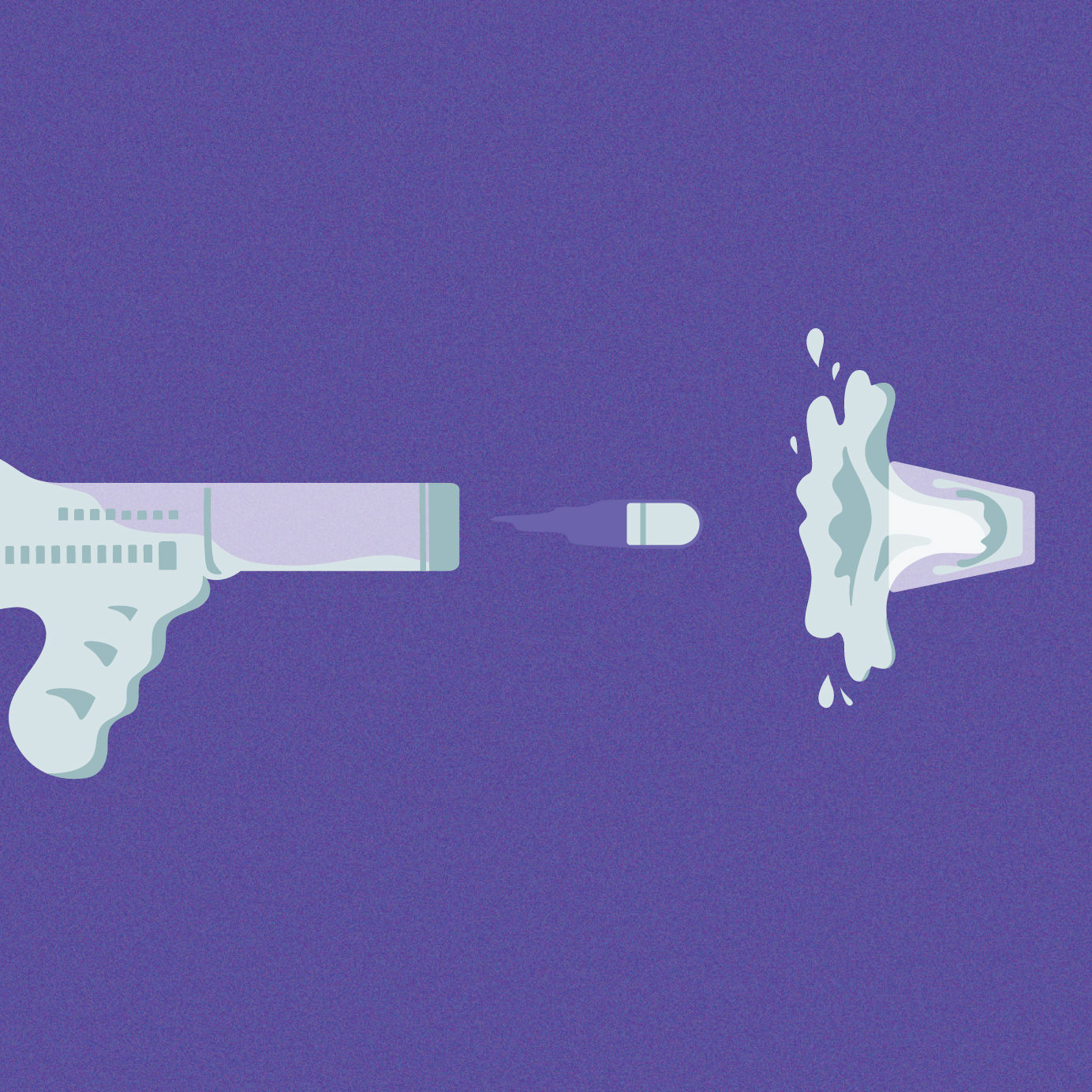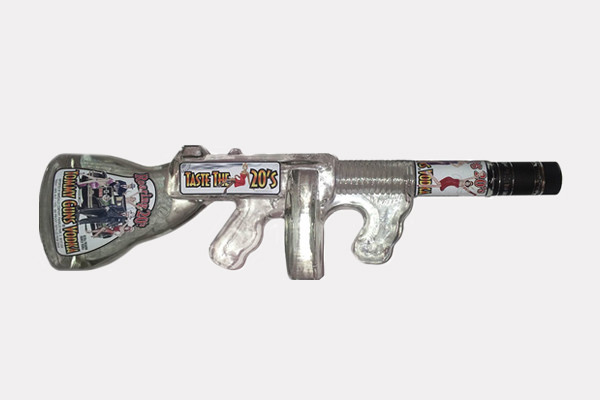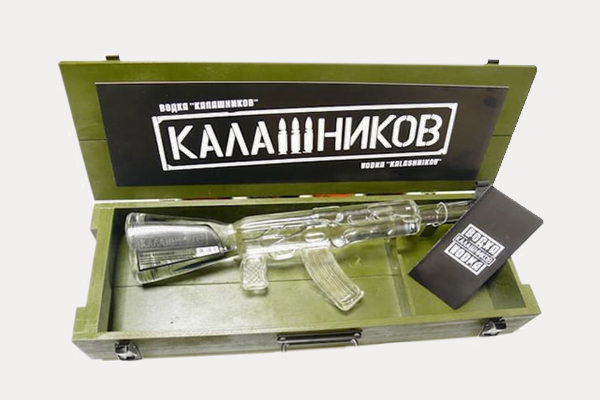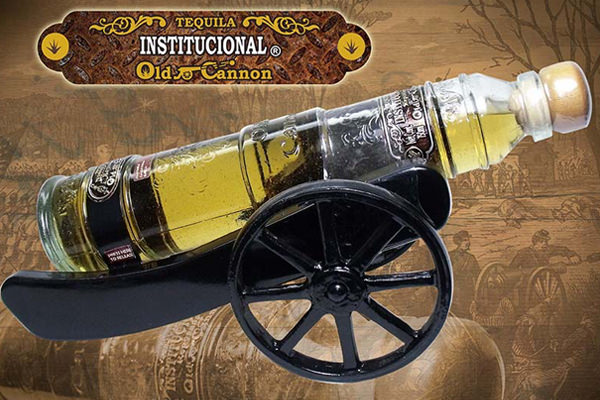It was another sleepy Friday night in Edmonton in the middle-class suburb of Dovercourt, Canada. During a routine traffic stop, police noticed a 24-year-old man behaving erratically, waving around — my goodness — a submachine gun. Eventually, he started pointing it at the EPS officers on the scene.
Fearing for their lives and the safety of others, the Canadian force proceeded with caution, calling for a tactical unit to disarm the man. As the perp was slammed to the ground, the police quickly learned the gun was loaded. So was the man.
When the drunk Canuck tossed his Tommy gun aside, it hit the sidewalk and shattered into smithereens. Vodka spilled from it into the street.
Tommy Dearest
Just three years earlier, in 2005, Alphonse Capone Enterprises had introduced Tommy Guns Vodka. The Chicagoland company had been able to trademark the name of the famous gangster — though not the word “Tommy gun” (singular) — and Tommy Guns Vodka was the first American product of its kind. A rye vodka packaged in a hand-blown glass bottle shaped like a Roaring ’20s-era Thompson submachine gun.
Not surprisingly, gun nuts took to it immediately.
“I seen this giant ass crazy looking bottle when i went to the liquor store after work today. (sic)” wrote a message board poster named Sgt JMo. “16oz. drum mag..COOL!! (sic)” wrote a similarly mindedgent on GunBroker.com. “Gimme a rat-a-tat-tat of that Tommy gun vodka! (sic)” wrote another on MachineGunBoards.
Even those of us who are not frequent visitors to ammunitions-centric web forums have likely seen Tommy Guns products (among other weaponized liquors) at our local package stores or internet distributors. Maybe you’ve even posed with one —without purchasing it! Always without purchasing it! — after spying it on a shelf. You’re at a duty free shop, you’re in a foreign country, maybe you’re just at some redneck liquor warehouse, and, good golly, there’s a “bottle” of vodka shaped like a Kalashnikov. A dagger of rum. A scabbard sheathing some brandy. Some whiskey in a damn grenade!
Plenty of listicles have covered this strange world of bottled weaponry — the silly vessels presumably make for page-view-crushing slideshows — but no one has really dug any deeper. I had to know: Where do they come from? Who was the first to make one? And does anyone actually buy these and drink from them? (Non-ironically I mean…)
https://www.instagram.com/p/9g-LFNTJB4/?tagged=tommygunsvodka
Visionquest
“Back in 1995, cigars were big and we created Al Capone Cigars, a premium, machine-made cigarillo. It just did phenomenally for years,” Tommy Guns Vodka’s Bill Brooks, Jr. tells me over the phone. It had taken weeks for me to track him down. “Somewhere around 2002, I was going to do an ashtray in the shape of a Tommy gun. Then I thought, ‘Hey, I wonder if I could do a bottle instead?’”
Brooks, a restless entrepreneur who once worked for Ross Perot, had since the 1970s owned an intriguing business outside Chicago in St. Charles, Illinois. For 30-plus years, until closing its doors in 2012, Al Capone’s Hideaway and Steakhouse wasn’t just a restaurant that purportedly once served as a Capone-supplied speakeasy. As of the mid-’90s, the steakhouse had also begun making its own branded products.
Besides the cigars, Brooks had contract-brewed beers (using nearby Two Brothers Brewing), like Swingin’ Stout, which utilized Tommy gun-shaped tap handles. He packaged wine under the Roaring ’20s label with goofy names such as Legs Chardonnay. The Hideway’s bar, featuring a menu riddled with bullet holes and blood splatters, was already serving the popular “Scarface” Al Capone Martini, made with vodka, chilled espresso, Cognac and Kahlúa. It only seemed natural to add a uniquely Capone-inspired spirit to the mix.
“At the time, there was a very simple shotgun that was made in Poland or Russia, with Russian vodka inside,” Brooks says. “So that was on the market, but it didn’t stand out to me. It was a dollar store version.” Brooks didn’t want to make a similarly humdrum product — he wanted something befitting the big-time bootlegger.
“You can’t just find bottle makers in the U.S. or Canada, though,” Brooks explains. He didn’t know anyone internationally, so he went to liquor industry trade shows, speaking to glass manufacturers. It turns out, producing such a silly-looking bottle takes a massive amount of technical skill. “They would all tell me it’s virtually impossible to produce it in one piece,” Brooks says. “Especially with all that detail and embossing you want — the gun cartridge, circular bullet cylinder, two-hand grips. I wanted it 19 inches tall. A normal bottle is maybe 13. No, it’s next to impossible, they all said.”
Finally he found a willing manufacturer in Italy. They produced a gun-shaped mold for a whopping $25,000. (Most bottle molds cost a couple thousand bucks.) Brooks claims it created a “a wonderful bottle,” but eventually the Italians grew frustrated with the tricky manufacturing processes.
“The problem is, when they’re making the bottle, liquid glass cools quickly,” Brooks says of the unusual shape. “It just melts and by the time the bottom portion is cooling off, the top is real soft, depending when it comes out of the mold. It’s a real bitch to make.”
His vodka source was even more vexed. “The distillery in Poland wouldn’t accept the bottles from Italy, because they wouldn’t stand perpendicular at all times,” he says. “While it was moving on the conveyer belt (filling system), it would tilt to the left or right, it would fall forward or backwards. This wasn’t your normal automated bottling process.”
Finally, after three years, Brooks found a French-owned Chinese factory able to use his mold and fill the finished bottles with French vodka. It was worth the effort.
Once packaged, it wasn’t hard to find retailers eager to stock the novelty nectar. Tommy Guns was quickly put in numerous U.S. Army and Air Force bases around the world and most local liquor stores. Brooks hired costumed flapper girls to pour samples of the $40 product for curious customers (at the time Grey Goose was the “most” premium vodka in stores at a mere $29.99 a bottle).
“That thing just flew off the shelves.” Brooks tells me. “Wow! I’d spent all that money, but I had created a bottle that literally sold itself!”
He’d savvily put his phone number on the label (1-866-SCARFACE) and was soon receiving calls in the middle of the night from drunken fans, many of them celebrities. “Danny Bonaduce, Mariah Carey, you name it,” he says. “Tommy Lee called at 5 in the morning. Tommy Lee with the Tommy Guns. Everyone wanted pictures with that bottle.”
https://www.instagram.com/p/BNTUNHCghtG/?hl=en&taken-by=janicetrainor09
Arms Race
In the dark corners of the liquor industry, when one company has a hit on its hands, imitators quickly follow. “When you’re making novelty products in this business, you’re going to eventually start dealing with novelty people,” Brooks claims, which sounds like some deep wisdom until you think more about it.
When Brooks was considering shifting the bottle manufacturing to a cheaper Mexican plant, he slipped up and sent a sample of the bottle to a man down there. Next thing he knew, cheap facsimiles were appearing on shelves in California, painted red and filled with tequila.
“It looked like a sick banjo,” Brooks says. “It sold well, but I don’t know who the hell would buy it.”
Though he didn’t want to name names, he was surely referring to Jalisco’s Grupo Industrial Muyaad and their Institucional “Prohibition Gun” Tequila (which had been first released in 2006 as Tommy Gun Tequila at $144.99 a gun). Brooks claims he sent some cease-and-desists — “Soooo much infringement!” — but he knew the difficulty and costs he would face in trying to battle a non-American company and track down all their products on the world’s markets. Not to mention, he felt they didn’t have the great marketing hook he did.
“The generation you want to be selling liquor to, say 21-to-40-year-olds, they love the gangster thing, Roaring ’20s, Al Capone,” Brooks says. “So a shotgun from Poland? Or Mexico? So what?!”
[Muyaad company CEO Abel Murillo didn’t answer my numerous calls and emails, and still hasn’t accepted an offer to join my professional network on LinkedIn.]
From this point on, a weapons bottle arms race exploded, largely due to Muyaad. The company released Eagle Shot, a handgun-shaped bottle. They issued Old Cannon, which served up tequila from a wheeled bottle cannon. The cheekily-named Fun Caliber, “The Original Revolutionary Gun,” was packaged with two bullet-shaped shot glasses. There was also Old Carbine, available in blanco, reposado, and anejo, and accompanied by a handsome stand to help you display your rifle upfront on your bar. There was machete-shaped tequila and Champs, bottled in a boxing glove. In 2011 Muyaad had its biggest hit with AK-T, a liters-worth of 100 percent agave tequila, smooth, and completely shootable.
As Packaging Digest — “The Voice of the Packaging Community since 1963!” —noted in their review of AK-T, “Despite the potential for controversy arising from concerns about packages that bring to mind gun and knife crime, these packs will nonetheless stand out on the shelf, which is important in this market.” Packaging Digest further found that 41 percent of young drinkers were more likely to try a liquor in novelty bottles.
Perhaps that’s why in Mexico there was soon Licores Veracruz’s Hijos de Villa rifle, created to celebrate the company’s oh-so-important 55th anniversary in 2006. (Marketing copy included such inspirational passages as “…which reflect the brave Mexican pride.”) You could even buy bullet-shaped 70-millilter bottles for refilling your 200-millilter weapon.
Internationalists had plenty of alternatives. Consider the camo-covered Sniper Gun Vodka, a Polish product for Chris Kyle fan boys. There was also Vodka Kalashnikov from Russia, coming in a snazzy cardboard carrying case, though that company sadly seems to have gone out of business.
“There are a lot of gun aficionados here, and the bottles are basically a collector’s item,” David Hernandez, founder of Houston’s Holiday Wine & Liquor stores, told the Houston Chronicle in 2012.
The American liquor industry had gone to novelty bottles in the past. Back in the 1950s and ’60s, an ugly era in which clear liquors dominated and no one was buying brown bourbon, Kentucky distilleries had to resort to putting their whiskeys in decorative decanters. Old Crow famously made a set of chess pieces — collect them all! Wild Turkey released popular poultry decanters for decades. And there it was: In 1968 Ezra Brooks made a quite-handsome, I must say, “flintlock dueling pistol” decanter. You can still find some on eBay.
Now that bourbon is once again king, novelty is no longer needed to move that juice. But that doesn’t mean gun-shaped bottles have nothing to offer the low-end vodkas and tequilas of the world.
Fireworks
You probably won’t be surprised to learn that hard alcohol sold in weapons-shaped bottles hasn’t been without controversy. There was a series of well-publicized arrests after drunks waved their bottles around. In 2007 a truck with $100,000-worth of drinkable Tommy Guns was stolen. In 2011 there was a Change.org petition trying to stop Sam’s Club from selling bottle guns. (“Is this really the kind of product mix of which Sam Walton … would have been proud?” wrote one concerned party. The petition garnered a mere 934 signatures.)
“I’ve always thought the ATF [or the Department of Justice’s Bureau of Alcohol, Tobacco, Firearms and Explosives] is an odd agency. “You’d think overseeing alcohol, tobacco and firearms would be very different tasks. But (a) rifle-shaped vodka bottle is perhaps the best argument I’ve seen for the ATF’s mandate,” joked blogger Sporkful. “I’m waiting for someone to figure out a way to make it smokeable.”
(Should I let him know many weed enthusiasts like to use empty Tommy Guns bottles as bongs?)
Across the pond, in 2014, missiles of Red Army Vodka were found in breach of U.K. alcohol marketing laws. Namely, “a drink, its packaging and any promotional material or activity should not in any direct or indirect way suggest any association with bravado, or with violent, aggressive, dangerous or antisocial behaviour.”
https://www.instagram.com/p/BTjQaGyDyj6/?taken-by=theatro_nightlife
Brooks had trouble getting big chain liquor stores to stock him in more conservative states, despite the fact that gun enthusiasts live in many of them. He claims that the Distilled Spirits Council of the United States (DISCUS) frequently includes complaints about him in their semi-annual trade association reports, but the U.S. government has never given him any flack.
That said, Brooks hasn’t been without a bevy of legal troubles. In 2013 Alphonse Capone Enterprises was sued by Saeilo Enterprises, a New York-based company owned by the Reverend Sun Myung Moon’s son Moon Kook-jin (a.k.a Justin Moon). The gun magnate manufactures and claims a trademark for literal Tommy guns.
“There’s a Colt .45 handgun, and they trademarked that, but there’s also a Colt 45 malt liquor, right? That’s also trademarked,” says Brooks. “Similar to me, but it didn’t matter. Having a trademark doesn’t guarantee you anything in America. (Moon) tried to bankrupt me.”
Brooks was in court for two-and-a-half years and spent hundreds of thousands of dollars fighting, he says. Even though he owned the trademark to a Tommy gun-shaped liquor bottle, he eventually had to settle. He angrily tells me he now has to pay licensing rights to Moon to continue selling his Tommy Guns Vodka.
Though Tommy Guns’ website doesn’t look functional, and their social media presence extends only so far as an old Myspace page with a few hundred fans, the company is very much alive, operational, and making money. Today, Tommy Guns’ bottles are still made in China, at the same factory that pumps out Dan Aykroyd’s skull-shaped Crystal Head Vodka. Now MSRP-ing around $50, Tommy Guns still sells pretty well — around 8,000 six-bottle cases per year.
Some Gun Like You
I finally got my hands on a bottle of Tommy Guns. The spirit is better than it needs to be — clean, grainy, and lacking many of those nail-polish-remover notes so many low-end vodkas produce.
Of course, no one on planet Earth buys Tommy Guns for the taste. Which makes me realize, people rarely buy any alcohol for the pure taste. No, most people buy it for what they want that bottle to say about them.
The squared-off Jack bottle with its black-and-white label says I’m a manly badass. The frosted glass Grey Goose says I’m pure class and reek of French sophistication. The hand-blown Patrón says I can totally afford bottle service, bro — and let’s do some shots. Drake’s whiskey bottle looks like a cologne bottle because if you buy it you’re probably the type of dude who wears too much cologne and doesn’t yet realize that.
And a bottle shaped like a gun says so many important things about the purchaser. To the drinker who buys it ironically, it says I’m a little goofy, playful. To one who buys it earnestly, it says I’m a little childish, probably overly aggressive, likely overcompensating for something in the phallus department.
Like Jack or Goose or Patrón, Tommy Guns is simply a bottle-based signifier-of-self. But to the nth degree.
https://www.instagram.com/p/BUcB4GUFnoh/?hl=en&taken-by=matbourgouin
“It’s not what you would call an ‘everyday’ bottle. It’s a novelty,” Brooks says. “You buy it for your office, put it on your mantle, display it in the man cave. Whether you drink it or not, you would never buy another, except as maybe a gift. Liquor fads last about a seven-year period, but Tommy Guns has gone longer than that.”
Now 71 years old, Brooks has fixed his sights on mastering that “everyday” bottle. Next year he plans to release pocket flasks with a Tommy gun merely embossed on them.



